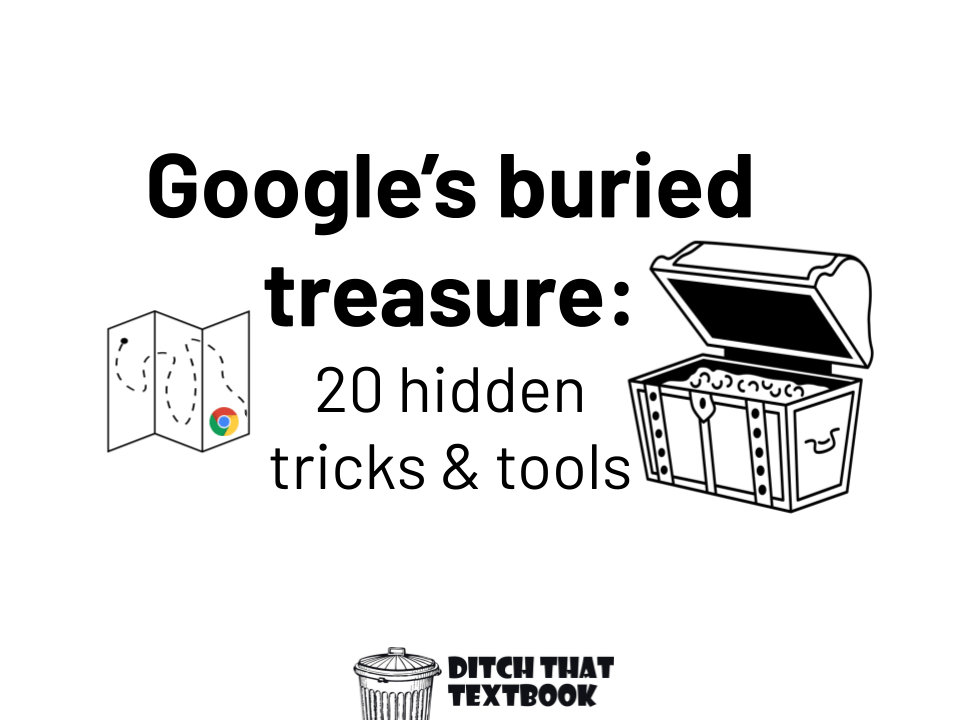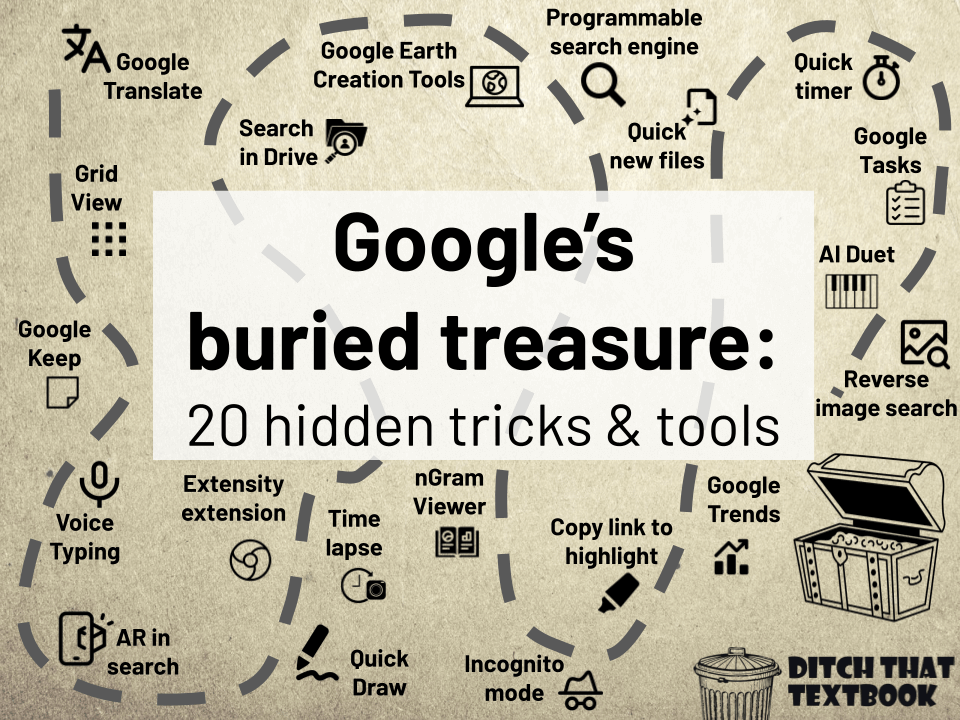
Google is a behemoth. With all of its tools and apps and programs and initiatives, there’s no way to keep tabs on everything.
As such, it’s easy for newer Google tools — and even some that have been around for a while — to slip through the cracks.
The problem with that: there are some really powerful, really unique offerings in the Googleverse that aren’t getting as much use by teachers.
Let’s work on that today!
In a recent #Ditchbook chat we asked our community to share some of their favorite lesser known Google tricks and tools. We added some of the ones shared along with a few of our own favorites to the list below. Also be sure to check out the whole chat recap in this Wakelet collection for even more great tips, tricks and tools shared.
Do you know of even more hidden Google treasures? Share them in the comments below!
Here are 20 hidden tricks and tools you might not have heard of.

1. AR in Google search
You can find some really cool AR right in Google search! On your Andriod or iPhone you can go to Goo
- On your Android phone, iPhone or iPad, go to google.com or open the Google app (it also works in Safari)
- Search for an animal, object, or place.
- If there is 3D result is available you'll see a 3D icon, click on View in 3D.
- Click View in your space then follow the on-screen instructions and experience the magic of AR.
Check out the full list of available AR experiences: Experience 3D & augmented reality in Search
2. Creation tools in Google Earth
Google recently added the ability to create Google Earth projects. In these projects, your students can stick pins to the globe, add rich media and detailed information, then present it step-by-step like a story.
Learn more: Creating with Google Earth: 10 activities to try
Did you know that you can create your own customized search engine that only shows results from the sites you want? It's great for younger students and you can even create your own search box to add to your website.
Shared by: Karyn Fillhart (Be sure to check out the tutorial video she shared too!)
4. Google Tasks
Get organized with Google Tasks. Sync your to-do list across all of your devices and manage and edit your tasks from anywhere, at anytime. You can use Google Tasks on desktop or get the app on Google Play on the App Store. Learn more: How to use Google Tasks.
Shared by: Adam Juarez along with his blog post Digital Organization Tips for Students with Gmail, Tasks and Calendar.
5. Grid view in Slides
Use the grid view to see all of your slides at one time. This is a great option for those collaborative Google Slides presentations because you can see all of the slides in real time.
Find out more about on this Grid View plus other secret tools in this post: The “secret menu” for Google Slides, Docs, Drawings and more
6. Copy link to highlight
If you want to send students or colleagues to a specific spot on a website in Chrome just highlight the text then right click to highlight link to text. This creates a link to that exact spot when it's clicked.
Shared by: Sean Fahey
Have too many extension icons in the top right of Chrome? Only run and display the ones you want with Extensity.
There are tons of hidden gems among extensions. Check out this post for lots of great ones. Google Chrome extensions galore! 50+ for the classroom
8. Quick Draw
Quick, Draw! tells you what to draw. Then, Google’s artificial intelligence tries to guess what you’re drawing. It’s a neat way to introduce students to artificial intelligence OR to look at how we convert words/ideas into images.
9. AI Duet
It’s a piano. You play some notes. A.I. Duet responds with its own notes. You make music together … with artificial intelligence.
10. Google Keep
Google Keep is like virtual sticky notes that go wherever you do. Use the mobile app to take notes while on the go or type them into Keep in your web browser. Add images, create labels to organize and even color code. This will become your favorite organizational Google tool!
- Google Keep (keep.google.com)
- Google Keep on iTunes and on Google Play
11. Incognito mode
Incognito isn’t a creepy tool to let you search for naughty things. When you use an Incognito window, it’s like all of the settings on your Google Chrome have been wiped. No account logged in. No location data. No cookies or anything. It’s useful to see things as if you’re not logged in (among others).
12. Set a timer
Want to give students a certain amount of time to complete a task? Do a Google search for “set a timer for two minutes” or any length of time. Google will create a timer for you and even start it automatically.
13. Use search in Google Drive
I used to be addicted to organizing my Drive by folders. Not anymore. I found that searching through folders is 2.5 times slower than doing a search to find a file.
- Tip for finding files faster in Drive: Create a naming convention for your files. Example: For me, I included the class, the unit and the chapter in my naming code. A file from Spanish 2, unit 4, chapter 1 would always have this code in it: IIU4C1. If I searched for IIU4C1, it would pull everything up for that particular chapter.
Watch how the satellite images of the world have changed over the last 20+ years. Choose a location on the map and Time Lapse will show you how that location has changed via satellite in motion.
15. Create quick new files
Instead of going to Google Drive and using the “New” button, try these links to create new files:
You can also use the Quick Create extension to create new files right from your browser bar.
16. Voice Typing
Docs will let you type with your voice. In a Google Doc, go to Tools > Voice typing … and click the microphone. It will dictate what you say. (This also works for typing speaker notes in Google Slides.)
- Voice typing: Click Tools > Voice typing … in Docs
Using the standard Google Images search, upload a photo to see where it’s been used on the Internet. At Google Images, click the camera in the search bar. Upload your photo and see where it’s been.
18. nGram Viewer
Google has scanned and indexed the words in thousands and thousands of books. Display a graph showing how often certain words show up over time.
This one’s been around a while, but there’s a somewhat hidden feature in the Google Translate app. Use your camera to translate written text on signs. Click the camera icon and aim your camera at some text. Google Translate will translate it on the screen for you.
20. Google Trends
Find out what’s hot in Google searches up to the moment. Filters let you see what’s popular in different countries over different time periods. You can even search preset categories.
For notifications of new Ditch That Textbook content and helpful links:
Are you looking for quality, meaningful professional learning that both equips and inspires teachers?
Matt provides in-person and virtual keynotes, workshops and breakout sessions that equip, inspire and encourage teachers to create change in their classrooms. Teachers leave with loads of resources. They participate. They laugh. They see tech use and teaching in a new light. Click the link below to contact us and learn how you can bring Matt to your school or district!
Is Matt presenting near you soon? Check out his upcoming live events!



very usefull post about google tips
I really liked your article a lot. It gave me so many new thing that I hardly knew about. Google slide Extension, Quick Draw and A.I. Duet are the things that I like the most. I am definitely going to try all of them. thanks for sharing.
[…] Here’s some of Google’s buried treasure: 18 hidden tricks and tools […]
One of my favorites is Tab Resize extension. It easily and quickly creates split screen modes (2, 3, 4. . .screens) which allows for ease in working on a document while doing research without having to switch windows constantly.
Google Voice is the best kept Google Secret – I love it more than Hangouts for using SMS and Voice Calls. I connect my Google Voice to my Hangouts so I can use Hangouts withing my Gmail.
These translate apps should change the way we teach in the Wl classroom!!!! It is important to show the kids how to use them, when and where to use them and to think critically when they use these apps!!! They are here to stay and are getting better as tech and AI advances are being made! Would love to see a post on this at some point?? I’m sure you have tons of ideas!!
Here is a quick example of Google Tour Builder I created for students working on an ecosystems/animals project to give you an idea of what Tour Builder can do.
https://tourbuilder.withgoogle.com/tour/ahJzfmd3ZWItdG91cmJ1aWxkZXJyEQsSBFRvdXIYgIDA_tObhwoM
My favorite gem in the Googleverse is Google Tour Builder (https://tourbuilder.withgoogle.com/). It combines a Slides presentation with Google Earth locations and allows for students or teachers to add links, videos, and photos to the tour. Because Tour Builder uses Google Earth, it also allows users to use Street View throughout the tour. I’ve used it with students to teach habitats, ecosystems, and geography, but the possibilities are endless!
As a HS English teacher, the citing of sources remains an arduous task because of the level of convincing it takes to get students to realize they MUST give credit where credit is deserved. I just discovered Apogee Citation Creator, which provides citation information and the setting can be changed from MLA to APA and back with a click. The simplicity with which this works in Google is amazing because it “reads” the source info while you are reading the page. I highly recommend it.